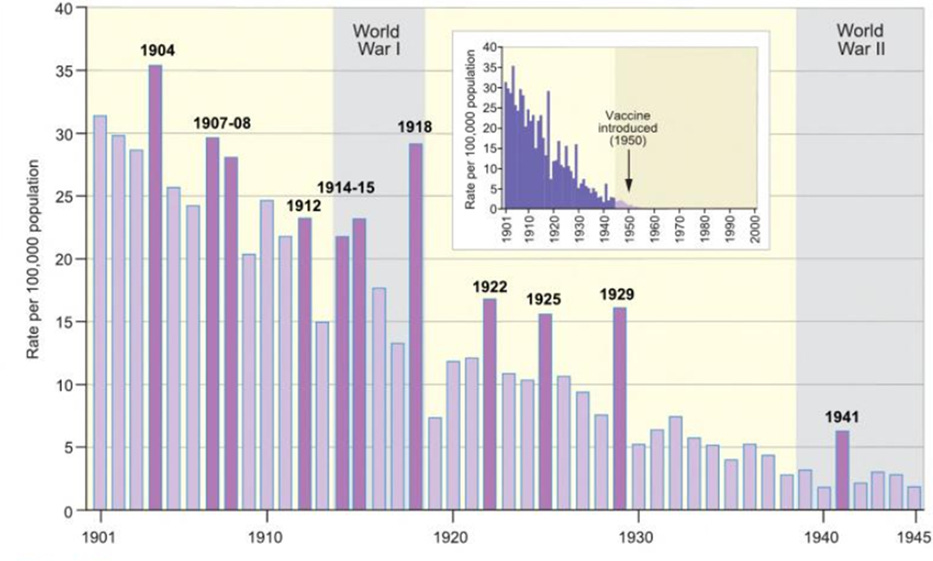The Vaccine Mistake Nobody Talks About
How DTaP May Have Misprogrammed a Generation's Immune Systems
“Most cases of whooping cough are relatively mild. Such cases are difficult to diagnose without a high index of suspicion because doctors are unlikely to hear the characteristic cough, which may be the only symptom. Parents can be reassured that a serious outcome is unlikely. Adults also get whooping cough, especially from their children, and get the same symptoms as children.”[1]
—D Jenkinson, 1995
“…it may be questioned whether universal vaccination against pertussis is always justified, especially in view of the increasingly mild nature of the disease and of the very small mortality. I am doubtful of its merits at least in Sweden, and I imagine that the same question may arise in some other countries. We should also remember that the modern infant must receive a large number of injections and that a reduction in their number would be a manifest advantage.”[2]
—Justus Ström, 1960
“As of 2022, after more than 60 years of experience with influenza vaccines, very little improvement in vaccine prevention of infection has been noted. As pointed out decades ago, and still true today, the rates of effectiveness of our best approved influenza vaccines would be inadequate for licensure for most other vaccine-preventable diseases...Taking all of these factors into account, it is not surprising that none of the predominantly mucosal respiratory viruses have ever been effectively controlled by vaccines... Durably protective vaccines against non-systemic mucosal respiratory viruses with high mortality rates have thus far eluded vaccine development efforts.”[3]
—Morens, Taubenberger, and Fauci, 2023
When the DTaP vaccine was introduced in the 1990s, it was hailed as a safer alternative to the older whole-cell pertussis vaccine. This characterization stemmed from its design: DTaP contains purified components of the Bordetella pertussis bacterium, whereas the whole-cell DTP vaccine used inactivated whole bacteria. Public health officials hoped it would reduce side effects while still protecting children from whooping cough (or Pertussis—that’s the “P” and DTP and the attenuated Pertussis “aP” in DTaP).
But what they didn’t realize—or at least didn’t fully understand—was that this change could permanently alter a child’s immune system's response to the disease for life. You read that right, “for life.”
And no one is talking about it.
The Problem: “Original Antigenic Sin”
There’s a concept in immunology called original antigenic sin. It refers to how your immune system tends to “stick” to the first version of a virus or bacteria it encounters. It builds a memory of that version—and when it sees something similar later, it reacts as if it's the same, even if it's not. This can weaken the immune response to future infections.
“The concept of original antigenic sin in influenza was suggested more than 60 years ago. The immunologic memory of children is such that with a second influenza A infection, the major antibody response is directed at the strain with which they were infected originally and not to the new infecting strain.”[4]
This is well known in influenza research—but now we know it may apply to pertussis and the DTaP vaccine, too.
What the Research Found
In a 2019 paper, pertussis expert Dr. James D. Cherry discussed how kids’ immune systems responded to the whooping cough bacteria depending on whether they’d been vaccinated with DTaP or not.
“…a study of adenylate cyclase toxin (ACT), the authors noted that children with a primary B pertussis infection had a vigorous antibody response to ACT. In contrast, the antibody response to ACT in those whose DTaP vaccine failed was blunted. At that time, the authors suggested that this was similar to “original antigenic sin” in influenza.”[5]
Children who were not vaccinated and got a natural pertussis infection had a strong immune response to a key toxin called adenylate cyclase toxin (ACT). However, children whose DTaP vaccine failed (meaning they got sick anyway) had a blunted response to ACT. Their immune systems didn’t react the way they should have.
Dr. Cherry compared this phenomenon to original antigenic sin. Because the DTaP vaccine only exposes the immune system to a few purified parts of the pertussis bacteria (instead of the whole thing), it creates a narrow immune memory. When a real infection hits later, the body doesn’t fully recognize or respond to it.
This could mean that everyone who got DTaP as a child is more vulnerable to whooping cough for the rest of their lives.
A Mistake With No Easy Fix
Dr. Cherry was clear:
“Because of linked-epitope suppression, all children who were primed by DTaP vaccines will be more susceptible to pertussis throughout their lifetimes, and there is no easy way to decrease this increased lifetime susceptibility.”[6]
Where “linked-epitope suppression” is another way of saying “original antigenic sin.”
That’s a heavy statement.
It means the vaccine created a long-term immune disadvantage—and there’s no simple way to reverse it.
So what’s the solution from public health officials?
More shots.
Instead of acknowledging this major design flaw, they just recommend more boosters. Dr. Cherry even suggests giving Tdap vaccines every three years to adolescents and adults who received DTaP as children—Tdap every three years for life.
But that’s not solving the underlying issue. That’s just damage control.
The Public Was Never Told
This is the part that’s hardest to swallow: doctors don’t tell you your immune system was misprogrammed. They don’t explain that the original DTaP vaccine may have set you up for a lifetime of incomplete protection. They just keep adding more boosters to the schedule.
And the average parent has no idea this is happening.
Everyone Should Understand This Blunder
This isn’t a conspiracy theory—it’s right there in the medical literature. The story of how scientists tried to make a safer vaccine but accidentally made people less protected in the long run is one that needs to be told. Don’t take my word for it, read the full research from one of the world’s top pertussis experts here:
J. D. Cherry, MD, “The 112-Year Odyssey of Pertussis and Pertussis Vaccines—Mistakes Made and Implications for the Future,” Journal of the Paediatric Infectious Diseases Society, September 2019, pp. 334–341, https://sboh.wa.gov/sites/default/files/2022-01/Tab09e-Cherry%20JPIDS%202019.pdf
Read it. Sit with it. Let the questions come.
How could such a significant oversight go unnoticed for so long?
Why weren’t we told that trying to make a 'safer' vaccine may have left people less protected in the long run?
Did our public health officials know? Do they know now? And if they do—why hasn’t anyone said anything?
This isn’t fringe speculation. It’s peer-reviewed science from one of the world’s top pertussis experts. So why the silence?
Read the research. Think critically. Then start asking the questions that deserve answers.
In Closing
What you are never told is that whooping cough deaths had already fallen dramatically before the introduction of the DTP vaccine. And yet, no one seems to be interested in why.
As noted in the Atlas of Epidemic Britain by Matthew Smallman-Raynor and Andrew Cliff,
“Whooping cough trends, 1901-45. The bar chart plots the annual series of deaths rates per 100,000 population for England and Wales. Sample years of unusually high mortality relative to the underlying trend are identified by the dark purple bars. The inset graph shows the period covered by the main graph in century-long perspective, 1901-2000. A total of 233,698 deaths from whooping cough were recorded in England and Wales during the twentieth century, with over 97 percent occurring in the period 1901-45. Source: data from Mortality Statistics Unit (2003).”[7]
This historical data suggests that improvements in sanitation, nutrition, and general public health measures were likely pivotal in reducing mortality long before the widespread introduction of vaccines. The decline in deaths was already well underway, and yet much of the focus remains on vaccination as the sole savior. Why is this vital piece of history overlooked? It’s a question that remains largely unexplored.
It’s time for honest conversations about vaccine science—not just uncritical celebrations of its successes, but clear-eyed examinations of its failures. The DTaP vaccine story is one of good intentions, unintended consequences, and a medical system that failed to course-correct or come clean.
The science is there. The consequences are real. And we all deserve to know the truth.
[1] D Jenkinson, “Natural Course of 500 Consecutive Cases of Whooping Cough: A General Practice Population Study,” British Medical Journal, vol. 310, February 1995, p. 299.
[2] Justus Ström, “Is Universal Vaccination Against Pertussis Always Justified?” British Medical Journal, October 22, 1960, p. 1186.
[3] Morens, Taubenberger, and Fauci, “Rethinking next-generation vaccines for coronaviruses, influenza viruses, and other respiratory viruses,” Cell Host and Microbe, January 11, 2023.
[4] J. D. Cherry, MD, “The 112-Year Odyssey of Pertussis and Pertussis Vaccines—Mistakes Made and Implications for the Future,” Journal of the Pediatric Infectious Diseases Society, September 2019, pp. 334-341, https://sboh.wa.gov/sites/default/files/2022-01/Tab09e-Cherry%20JPIDS%202019.pdf
[5] J. D. Cherry, MD, “The 112-Year Odyssey of Pertussis and Pertussis Vaccines—Mistakes Made and Implications for the Future,” Journal of the Pediatric Infectious Diseases Society, September 2019, pp. 334-341, https://sboh.wa.gov/sites/default/files/2022-01/Tab09e-Cherry%20JPIDS%202019.pdf
[6] J. D. Cherry, MD, “The 112-Year Odyssey of Pertussis and Pertussis Vaccines—Mistakes Made and Implications for the Future,” Journal of the Pediatric Infectious Diseases Society, September 2019, pp. 334-341, https://sboh.wa.gov/sites/default/files/2022-01/Tab09e-Cherry%20JPIDS%202019.pdf
[7] Matthew Smallman-Raynor and Andrew Cliff, Atlas of Epidemic Britain: A Twentieth Century Picture, 2012, Oxford University Press, p. 52.






That vaccine study for safety? It HAS been done. Dr. Thomas appeared to be referencing a study by a European hexavalent vaccine manufacturer, GlaxoSmithKline (GSK). In 2011, GSK produced a confidential report on SIDS. However, an Italian court forced GSK to make the report publicly available. In the report, sudden deaths that occurred within 20 days after hexavalent vaccination were tabulated. The manufacturer concluded that all sudden deaths were reported within days of receiving a vaccine. Following the study, GSK sealed the report on its findings. https://slaynews.com/news/top-pediatrician-vaccines-cause-97-sudden-infant-deaths/?fbclid=IwY2xjawJqsXFleHRuA2FlbQIxMAABHnN3jY70iwINkMudFP-pvynDRmm69q-pf5ihJjRLSZapEU-RHSlxM3V82ymr_aem_Wf9EJGd32GLTq_cSuIhRDg
Childhood vaccines = a steady line of patients for big pharma in the decades ahead. There is no reason to ever vaccinate anyone since vaccines are 100% poisons, not health serums and they certainly offer no protection against anything your body cannot already protect you from.